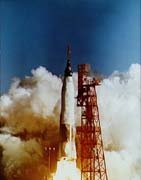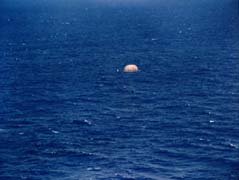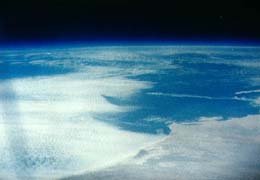Project Mercury History  On October 7, 1958 implementation was started to begin the U.S. national manned space-flight project, which was later dubbed Project Mercury. The Mercury program saw dynamic activity with the program lasting for over four and a half years, which brought together more then two million government employees to undertake this gigantic program. There were 25 total flights in the Mercury program, with six of which being manned space flights. When unmanned rockets were launched they either were empty of carried chimpanzees. During this time, much was learned about man's capabilities in the space environment. There were three main goals of the Mercury program, which were: Place a manned spacecraft in orbit around the Earth, investigate the astronaut's performance capabilities and his ability to function in outer space, and to recover the spacecraft and astronaut safely. The Mercury spacecraft was a cone-shaped capsule that held one astronaut and had a cylinder mounted to the top. An escape tower was mounted to the top of the cylinder and would served as an emergency escape away from the rocket during the launch. The blunt end of the capsule was a heat shield that protected the spacecraft from temperatures that reached 3000 F degrees during reentry into the atmosphere. Project Mercury used two types of On October 7, 1958 implementation was started to begin the U.S. national manned space-flight project, which was later dubbed Project Mercury. The Mercury program saw dynamic activity with the program lasting for over four and a half years, which brought together more then two million government employees to undertake this gigantic program. There were 25 total flights in the Mercury program, with six of which being manned space flights. When unmanned rockets were launched they either were empty of carried chimpanzees. During this time, much was learned about man's capabilities in the space environment. There were three main goals of the Mercury program, which were: Place a manned spacecraft in orbit around the Earth, investigate the astronaut's performance capabilities and his ability to function in outer space, and to recover the spacecraft and astronaut safely. The Mercury spacecraft was a cone-shaped capsule that held one astronaut and had a cylinder mounted to the top. An escape tower was mounted to the top of the cylinder and would served as an emergency escape away from the rocket during the launch. The blunt end of the capsule was a heat shield that protected the spacecraft from temperatures that reached 3000 F degrees during reentry into the atmosphere. Project Mercury used two types of launch vehicle: A Redstone rocket for sub orbital flights and an Atlas for orbital flights. On May 5, 1961, Alan Shepard rode his Mercury-Redstone 3 for a period of 15 minutes and 28 seconds, while in sub orbital flight. Following in his footsteps, Virgil Grissom completed a second sub orbital flight that lasted for 15 minutes and 37 seconds. The mission was successful, but upon splashdown the hatch of Liberty Bell 7 blew off and the Mercury capsule sank to the bottom of the ocean. Astronaut Virgil Grissom did manage to have gotten away in time and the Mercury program moved into its next phase. The first American to reach orbital space-flight was Astronaut John Glenn aboard Friendship 7, which roared to the heavens on February 20, 1962. John Glenn remained in orbit for 4 hours, 55 minutes, and 23 seconds and circled the Earth three times before returning home. Astronaut Scott Carpenter followed up Glenn's flight with a repeat that lasted 4 hours, 56 minutes, and 5 seconds. Next came a six orbit flight that left Astronaut Walter Schirra, Jr. in flight for 9 hours, 13 launch vehicle: A Redstone rocket for sub orbital flights and an Atlas for orbital flights. On May 5, 1961, Alan Shepard rode his Mercury-Redstone 3 for a period of 15 minutes and 28 seconds, while in sub orbital flight. Following in his footsteps, Virgil Grissom completed a second sub orbital flight that lasted for 15 minutes and 37 seconds. The mission was successful, but upon splashdown the hatch of Liberty Bell 7 blew off and the Mercury capsule sank to the bottom of the ocean. Astronaut Virgil Grissom did manage to have gotten away in time and the Mercury program moved into its next phase. The first American to reach orbital space-flight was Astronaut John Glenn aboard Friendship 7, which roared to the heavens on February 20, 1962. John Glenn remained in orbit for 4 hours, 55 minutes, and 23 seconds and circled the Earth three times before returning home. Astronaut Scott Carpenter followed up Glenn's flight with a repeat that lasted 4 hours, 56 minutes, and 5 seconds. Next came a six orbit flight that left Astronaut Walter Schirra, Jr. in flight for 9 hours, 13  minutes, and 11 seconds. The final Mercury flight came on May 15-16, 1963, with the 34-hour orbital flight of Astronaut Cooper aboard Faith 7. You may have wondered why all the manned Mercury missions have a 7 appear after their names, this was due to commemorate the first seven astronauts and their teamwork in the American space-flight program. Project Mercury was highly successful and it broke the barrier of putting American's into space. Amazing not a single soul was lost in this highly dangerous project that pitted technology with the unknown. Mercury brought American's to space and gained the knowledge needed for longer durations of space flight, that would later become the Gemini project. minutes, and 11 seconds. The final Mercury flight came on May 15-16, 1963, with the 34-hour orbital flight of Astronaut Cooper aboard Faith 7. You may have wondered why all the manned Mercury missions have a 7 appear after their names, this was due to commemorate the first seven astronauts and their teamwork in the American space-flight program. Project Mercury was highly successful and it broke the barrier of putting American's into space. Amazing not a single soul was lost in this highly dangerous project that pitted technology with the unknown. Mercury brought American's to space and gained the knowledge needed for longer durations of space flight, that would later become the Gemini project.
Unmanned Missions LJ-1 (Little Joe 1)- Mission consisted of Max Q abort and escape test. Objective was to determine how well the escape rocket would function under the most severe dynamic loading conditions anticipated during a Mercury-Atlas launching. Mission failed due to explosion on the launch pad prior to launch, due to an electrical leak on the escape rocket. BJ-1 (Big Joe 1)- Mission was to test the ablation heat shield. The nose-cone capsule for Big Joe had no retrorocket package. The inner structure held only a half-sized instrumented pressure vessel instead of a pressurized cabin contoured to the outer configuration. Spacecraft test was successful, but the launch vehicle failed. The two outboard engines had not separated from the centerline sustainer engine after their fuel was exhausted. The added weight of the booster engines slowed the velocity by 3000 feet per second resulting in the capsule separating from the booster 138 seconds too late. The impact point was 500 miles short. LJ-6 (Little Joe 6)- Test of Capsule aerodynamics and integrity, with the mission being partly successful. LJ-1A (Little Joe 1A)- Mission was Max Q abort and escape testing, mission was considered partial success. LJ-2 (Little Joe 2)- Consisted of Sam the Monkey as passenger. Mission was Max Q abort and escape testing, mission was considered successful. LJ-1B (Little Joe 1B)- Consisted of Miss Sam the Monkey as passenger of Max Q abort and escape tests. Mission was successful. BA-1 (Beach Abort)- Mission to test off-the-pad escape system. Mission Successful. MA-1 (Mercury Atlas 1)- Mission was to qualify spacecraft and Atlas combination. The specific test objectives were: 1) Recover the capsule. 2) Determine the structural integrity of the Mercury capsule structure and after body shingles under the maximum heating conditions which could be encountered from an orbital launching. 3) Determine Mercury capsule after body heating rates during reentry. 4) Determine the flight dynamic characteristics of the Mercury capsule during reentry. 5) Determine the adequacy of the Mercury capsule recovery systems. 6) Familiarize Project Mercury operating personnel with launch and recovery operations. Mission was deemed a failure. LJ-5 (Little Joe 5)- Mission was to qualify MAC Spacecraft at Max Q. Mission a failure. MR-1 (Mercury-Redstone 1)- Mission to qualify spacecraft and Redstone combination. Mission Failure. MR-1A (Mercury-Redstone 1A)- Mission was to qualify systems for sub orbital operations; mission was considered successful. MR-2 (Mercury-Redstone 2)- Passenger was Ham the Chimp. Mission was primate sub orbital and auto abort testing. Spacecraft successful, with the launch vehicle only partially successful. MA-2 (Mercury Atlas 2)- Mission was to qualify Mercury Atlas interfaces; Mission was successful. LJ-5A (Little Joe 5A)- Mission of Max Q escape and impact test. Purpose was to demonstrate primarily the structural integrity of the highest dynamic pressure anticipated during an Atlas launch for orbital flight. Mission was partial successful, but mission objectives were not met. MR-BD (Mercury BD)- Mission to perfect Mercury Redstone Booster Operations. Qualify booster for manned operation. Mission was fully successful. MA-3 (Mercury Atlas 3)- Mission was a quick test of spacecraft and Atlas orbit. Mission listed as a failure. Forty seconds after the Atlas left the pad, the vehicle was destroyed by the Range Safety Officer. The mercury spacecraft separated and was recovered. LJ-5B (Little Joe 5B)- Mission of Max Q escape and sequence. Spacecraft tests were successful, with launch vehicle tests partially successful. MA-4 (Mercury Atlas 4)- Mission of testing the spacecraft's Environmental Control System in orbit. Mission was partial successful. MS-1 (Mercury Scout 1)- Testing of Mercury Scout launch configuration. Mission was considered a failure. MA-5 (Mercury Atlas 5)- Passenger was Enos the Chimp with primate testing of Environmental Control System in orbit. Spacecraft partial success, with the launch vehicle being successful. Enos the Chimp did fare well, but faced some small problems with temperature control. Manned Missions MR-3 (Freedom 7)- Freedom 7 was piloted by Astronaut Alan B. Shephard, Jr. The main scientific objective of MR-3 was to determine man's capabilities in a space environment and in those environments to which he will be subject upon going into and returning from space. A few of the basic flight problems included: The development of an automatic escape system, vehicle control during insertion, behavior of space systems, evaluation of pilots capabilities in space, in flight monitoring, retrofire and reentry maneuvers and landing and recovery. The mission was successful, with a flight time of 15 minutes and 28 seconds. (Launch: May 5, 1961. 9:34 A.M. EST; Landing: May 5, 1961. 9:49 A.M. EST) MR-4 (Liberty Bell 7)- Crew of Liberty Bell 7 consisted of Virgil I. "Gus" Grissom. Mercury-Redstone 4 was the fourth mission in the Mercury-Redstone series of flight tests and the second U.S. manned sub orbital space flight. It was the next step in the progressive research, development and training program leading to the study of man's capabilities in a space environment during manned orbital flight. The main objective was to corroborate the man-in-space concept. The main configuration differences between the MR-3 spacecraft was the addition of a large viewing window and an explosively actuated side hatch. Flight successful but the spacecraft was lost during the post landing recovery period as a result of premature actuation of the explosively actuated side egress hatch. The capsule sank in 15,000 feet of water shortly after splashdown. The astronaut egressed from the spacecraft immediately after hatch actuation and was retrieved after being in the water for about 3 to 4 minutes. Mission lasted for a duration of 15 minutes and 37 seconds. (Launch: July 21, 1961. 7:20 A.M. EST; Landing: July 21, 1961. 7:35 A.M. EST) MA-6 (Friendship 7)- Astronaut of Friendship 7 was John H. Glenn, Jr. Place a man into earth orbit, observe his reactions to the space environment and safely return him to earth to a point where he could be readily found. The Mercury flight plan during the first orbit was to maintain optimum spacecraft attitude for radar tracking and communication checks. Mission was successful and John Glenn became the first American to orbit the Earth. During the flight only two major problems were encountered: 1) a yaw attitude control jet apparently clogged at the end of the first orbit, forcing the astronaut to abandon the automatic control system for the manual-electrical fly-by-wire system; and 2) a faulty switch in the heat shield circuit indicated that the clamp holding the shield had been prematurely released- a signal later found to be false. During reentry, however, the retro pack was not jettisoned but retained as a safety measure to hold the heat shield in place in the event it had loosened. Mission lasted for 4 hours, 55 minutes, and 23 seconds after a period of three orbits. (Launch: February 20, 1962. 9:47 A.M. EST; Landing: February 20, 1962. 2:43 P.M. EST) MA-7 (Aurora 7)- Crew of Aurora 7 consisted of Scott M. Carpenter. Corroborate man-in orbit and follow-up on Friendship 7 mission. The performance of the Mercury spacecraft and Atlas launch vehicle was excellent in nearly every respect. All primary mission objectives were achieved. The single mission critical malfunction which occurred involved a failure in the spacecraft pitch horizon scanner, a component of the automatic control system. This anomaly was adequately compensated for by the pilot in subsequent in-flight operations so that the success of the mission was not compromised. Mission duration was 4 hours, 56 minutes, and 5 seconds after a period of three orbits around the earth. (Launch: May 24, 1962. 7:45 A.M. EST; Landing: May 24, 1962. 12:41 P.M. EST) MA-8 (Sigma 7)- Sigma 7 was piloted by Astronaut Walter M. Schirra, Jr. Main mission was of a man-machine in orbit for a 9 hour period. Mission was successful and flight time was 9 hours, 13 minutes, and 11 seconds with 6 completed orbits. MA-9 (Faith 7)- Astronaut of Faith 7 was Gordon L. Cooper. Mission was to go for a manned one day mission in orbit. Mission was successful and total flight time reached 1 day, 10 hours, 19 minutes, and 49 seconds. |